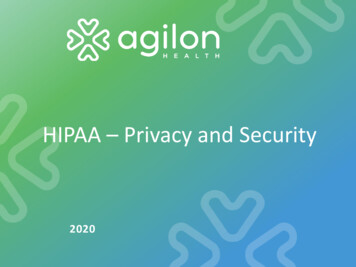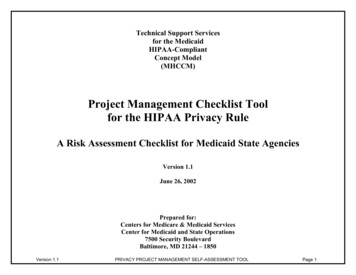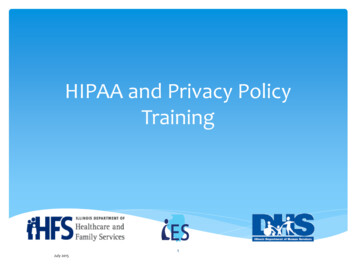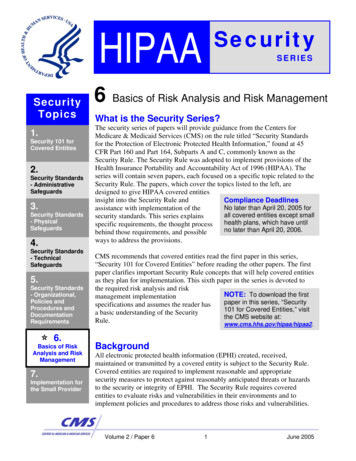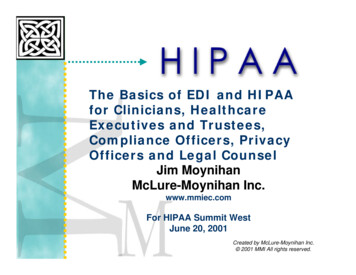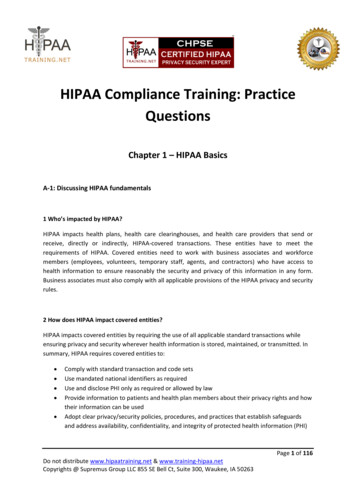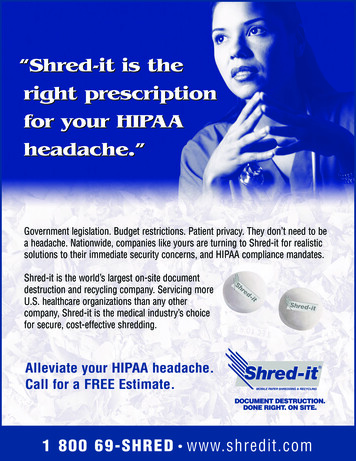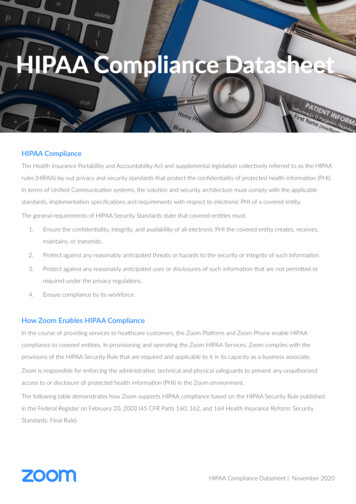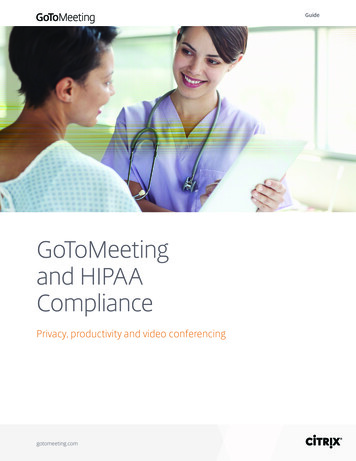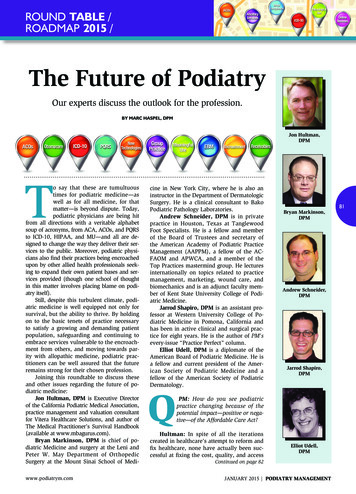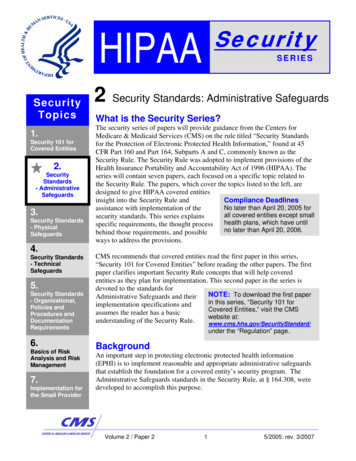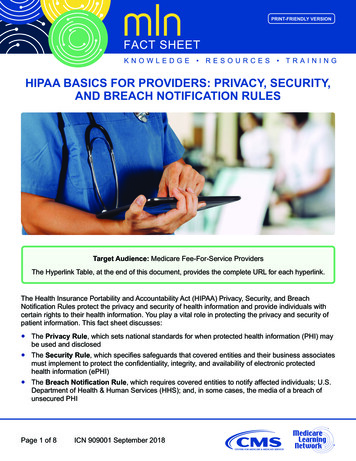
Transcription
PRINT-FRIENDLY VERSIONHIPAA BASICS FOR PROVIDERS: PRIVACY, SECURITY,AND BREACH NOTIFICATION RULESTarget Audience: Medicare Fee-For-Service ProvidersThe Hyperlink Table, at the end of this document, provides the complete URL for each hyperlink.The Health Insurance Portability and Accountability Act (HIPAA) Privacy, Security, and BreachNotification Rules protect the privacy and security of health information and provide individuals withcertain rights to their health information. You play a vital role in protecting the privacy and security ofpatient information. This fact sheet discusses: The Privacy Rule, which sets national standards for when protected health information (PHI) maybe used and disclosed The Security Rule, which specifies safeguards that covered entities and their business associatesmust implement to protect the confidentiality, integrity, and availability of electronic protectedhealth information (ePHI) The Breach Notification Rule, which requires covered entities to notify affected individuals; U.S.Department of Health & Human Services (HHS); and, in some cases, the media of a breach ofunsecured PHIPage 1 of 8ICN 909001 September 2018
HIPAA Basics for Providers: Privacy, Security, and Breach Notification RulesMLN Fact SheetHIPAA PRIVACY RULEThe HIPAA Privacy Rule establishes standards to protect PHI held by these entities and theirbusiness associates: Health plans Health care clearinghouses Health care providers that conduct certain health care transactions electronicallyWhen “you” is used in this fact sheet, we are referring to these entities and persons.The Privacy Rule gives individuals important rights with respect to their protected PHI, including rightsto examine and obtain a copy of their health records in the form and manner they request, and to askfor corrections to their information. Also, the Privacy Rule permits the use and disclosure of healthinformation needed for patient care and other important purposes.PHIThe Privacy Rule protects PHI held or transmitted by a covered entity or its business associate, in anyform, whether electronic, paper, or verbal. PHI includes information that relates to all of the following: The individual’s past, present, or future physical or mental health or condition The provision of health care to the individual The past, present, or future payment for the provision of health care to the individualPHI includes many common identifiers, such as name, address, birth date, and Social Security number.Visit the HHS HIPAA Guidance webpage for guidance on: De-identifying PHI to meet HIPAA Privacy Rule requirements Individuals’ right to access health information Permitted uses and disclosures of PHIHIPAA SECURITY RULEThe HIPAA Security Rule specifies safeguards that covered entities and their business associatesmust implement to protect ePHI confidentiality, integrity, and availability.Covered entities and business associates must develop and implement reasonable and appropriatesecurity measures through policies and procedures to protect the security of ePHI they create,receive, maintain, or transmit. Each entity must analyze the risks to ePHI in its environment andcreate solutions appropriate for its own situation. What is reasonable and appropriate depends onPage 2 of 8ICN 909001 September 2018
HIPAA Basics for Providers: Privacy, Security, and Breach Notification RulesMLN Fact Sheetthe nature of the entity’s business as well as its size, complexity, and resources. Specifically, coveredentities must: Ensure the confidentiality, integrity, and availability ofall ePHI they create, receive, maintain, or transmit Identify and protect against reasonably anticipatedthreats to the security or integrity of the ePHI Protect against reasonably anticipated, impermissibleuses or disclosures Ensure compliance by their workforceWhen developing and implementing Security Rulecompliant safeguards, covered entities and theirbusiness associates may consider all ofthe following:Confidentiality: ePHI is not availableor disclosed to unauthorized personsor processesIntegrity: ePHI is not altered ordestroyed in an unauthorized mannerAvailability: ePHI is accessible andusable on demand by authorizedpersons Size, complexity, and capabilities Technical, hardware, and software infrastructure The costs of security measures The likelihood and possible impact of risks to ePHICovered entities must review and modify security measures to continue protecting ePHI in achanging environment.Visit the HHS HIPAA Guidance webpage for guidance on: Administrative, physical, and technical safeguards Cybersecurity Remote and mobile use of ePHIHIPAA BREACH NOTIFICATION RULEThe HIPAA Breach Notification Rule requires covered entities to notify affected individuals; HHS;and, in some cases, the media of a breach of unsecured PHI. Generally, a breach is an impermissibleuse or disclosure under the Privacy Rule that compromises the security or privacy of PHI.The impermissible use or disclosure of PHI is presumed to be a breach unless you demonstratethere is a low probability the PHI has been compromised based on a risk assessment of at least thefollowing factors: The nature and extent of the PHI involved, including the types of identifiers and the likelihood ofre-identification The unauthorized person who used the PHI or to whom the disclosure was madePage 3 of 8ICN 909001 September 2018
HIPAA Basics for Providers: Privacy, Security, and Breach Notification RulesMLN Fact Sheet Whether the PHI was actually acquired or viewed The extent to which the risk to the PHI has been mitigated.Most notifications must be provided without unreasonable delay and no later than 60 days followingthe breach discovery. Notifications of smaller breaches affecting fewer than 500 individuals maybe submitted to HHS annually. The Breach Notification Rule also requires business associates ofcovered entities to notify the covered entity of breaches at or by the business associate.Visit the HHS HIPAA Breach Notification Rule webpage for guidance on: Administrative requirements and burden of proof How to make unsecured PHI unusable, unreadable, or indecipherable to unauthorized individuals Reporting requirementsWHO MUST COMPLY WITH HIPAA RULES?Covered entities and business associates, as applicable, must follow HIPAA rules. If an entity doesnot meet the definition of a covered entity or business associate, it does not have to comply with theHIPAA rules. For the definitions of “covered entity” and “business associate,” see the Code of FederalRegulations (CFR) Title 45, Section 160.103.Covered EntitiesThe following covered entities must follow HIPAA standards and requirements: Covered Health Care Provider: Any provider of medical or other health care services or supplieswho transmits any health information in electronic form in connection with a transaction for whichHHS has adopted a standard, such as:Nursing ogistsDoctors Health Plan: Any individual or group plan that provides or pays the cost of health care, such as:Company health plansHealth insurance companiesGovernment programs that payfor health care, such as Medicare,Medicaid, and the military and veterans’health care programsHealth maintenance organizations (HMOs)Page 4 of 8ICN 909001 September 2018
HIPAA Basics for Providers: Privacy, Security, and Breach Notification RulesMLN Fact Sheet Health Care Clearinghouse: A public or private entity that processes another entity’s health caretransactions from a standard format to a non-standard format, or vice versa, such as:Billing servicesRepricing companiesCommunity health managementinformation systemsValue-added networksBusiness AssociatesA business associate is a person or organization, other than a workforce member of a covered entity,that performs certain functions on behalf of, or provides certain services to, a covered entity thatinvolve access to PHI. A business associate can also be a subcontractor responsible for creating,receiving, maintaining, or transmitting PHI on behalf of another business associate. Businessassociates provide services to covered entities that include: Accreditation Billing Financial services Legal services Claims processing Consulting Management administration Utilization review Data analysisNOTE: A covered entity can be a business associate of another covered entity.If a covered entity enlists the help of a business associate, then a written contract or otherarrangement between the two must: Detail the uses and disclosures of PHI the business associate may make Require the business associate safeguard the PHIVisit the HHS HIPAA Covered Entities and Business Associates webpage for more information.Page 5 of 8ICN 909001 September 2018
HIPAA Basics for Providers: Privacy, Security, and Breach Notification RulesMLN Fact SheetEnforcementThe HHS Office for Civil Rights enforces the HIPAA Privacy, Security, and Breach Notification Rules.Violations may result in civil monetary penalties. In some cases, criminal penalties enforced by theU.S. Department of Justice may apply.Common violations include: Impermissible PHI use and disclosure Use or disclosure of more than the minimumnecessary PHI Lack of PHI safeguards Lack of administrative, technical, or physicalePHI safeguards Lack of individuals’ access to their PHIThe following are actual case examples: HIPAA Privacy and Security Rule: A wireless health service provider (remote mobile monitoring)agreed to pay 2.5 million and implement a corrective action plan to settle potential violations ofthe HIPAA Privacy and Security Rules. A laptop with 1,391 individuals’ ePHI was stolen from anemployee’s vehicle. The investigation revealed insufficient risk analysis and risk managementprocesses in place at the time of the theft. Additionally, the organization’s policies and proceduresimplementing HIPAA Security Rule standards were in draft form and had not been implemented.Further, the organization was unable to produce any final policies or procedures regarding theimplementation of safeguards for ePHI, including those for mobile devices. HIPAA Breach Notification Rule: A specialty clinic agreed to pay 150,000 to settle potentialviolations of the HIPAA rules. An unencrypted thumb drive with the ePHI of about 2,200individuals was stolen from a clinic employee’s vehicle. The investigation revealed the clinic hadnot accurately or thoroughly analyzed the potential risks and vulnerabilities to the confidentialityof ePHI as part of its security management process. Further, the clinic did not fully comply withrequirements of the Breach Notification Rule to have written policies and procedures in place andtrain workforce members. This case was the first settlement with a covered entity for not havingpolicies and procedures to address the HIPAA Breach Notification Rule. Criminal prosecution: A former hospital employee pleaded guilty to criminal HIPAA chargesafter obtaining PHI with the intent to use it for personal gain. He was sentenced to 18 months inFederal prison.Visit the HHS HIPAA Compliance and Enforcement webpage for more information.Page 6 of 8ICN 909001 September 2018
HIPAA Basics for Providers: Privacy, Security, and Breach Notification RulesMLN Fact SheetResourcesRefer to the HHS Special Topics in Health Information Privacy webpage for information on: Cloud computing Mobile apps HIPAA regulation historyTable 1. HIPAA Privacy, Security, and Breach Notification ResourcesFor More Information About Covered EntitiesResourceCovered Entity titiesChart20160617.pdfFast es/fast-factsBusiness ntprovisionsFrequently Asked essassociatesCommunicating with a Patient’s Family, Friends,or Others Involved in the Patient’s CareHHS.gov/sites/default/files/provider ffg.pdfEmergency Situations: Preparedness, Planning,and pics/emergency-preparednessPHI paa/enforcement/examples/disposalfaqs.pdfPrivacy and Security of Electronic HealthRecords Model Notices of Privacy uidance/model-notices-privacy-practicesPage 7 of 8ICN 909001 September /mental-health
HIPAA Basics for Providers: Privacy, Security, and Breach Notification RulesMLN Fact SheetTable 1. HIPAA Privacy, Security, and Breach Notification Resources (cont.)For More Information About ResourceOmnibus HIPAA Final Rule (2013 013to the HIPAA Privacy, Security, Enforcement, and 01073.pdfBreach Notification Rules)Security Rule Guidance uidanceTraining able 2. Hyperlink TableEmbedded HyperlinkComplete URLCode of Federal Regulations (CFR) Title 45,Section 160.103https://www.ecfr.gov/cgi-bin/text-idx?SID 2e74ee451fc72a29cdf7e67af5219ce6&mc true&node pt45.1.160&rgn div5#se45.1.160 1103HHS Special Topics in Health ofessionals/special-topicsHIPAA Breach Notification each-notificationHIPAA Compliance and nals/compliance-enforcementHIPAA Covered Entities and ofessionals/covered-entitiesHIPAA s/privacy/guidanceMedicare Learning Network Product DisclaimerThe Medicare Learning Network , MLN Connects , and MLN Matters are registered trademarks of the U.S.Department of Health & Human Services (HHS).Page 8 of 8ICN 909001 September 2018
implementing HIPAA Security Rule standards were in draft form and had not been implemented. Further, the organization was unable to produce any final policies or procedures regarding the implementation of
